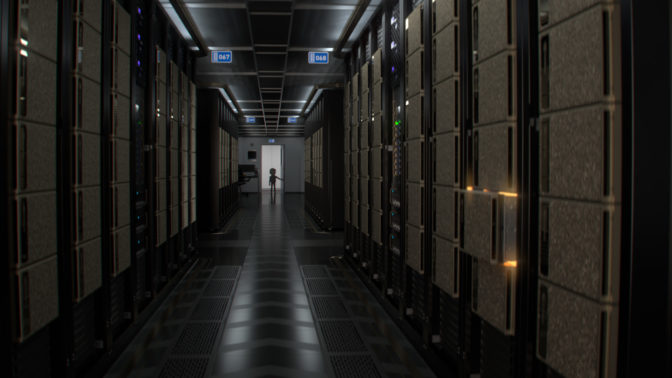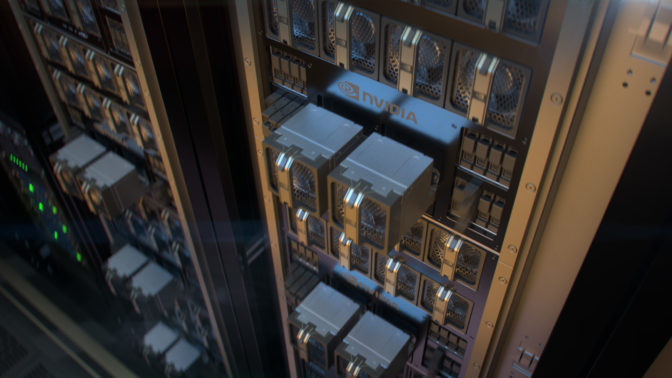The hum of a bustling data center is music to an AI developer’s ears — and NVIDIA data centers have found a rhythm of their own, grooving to the swing classic “Sing, Sing, Sing” in this week’s GTC keynote address.
The lighthearted video, created with the NVIDIA Omniverse platform, features Louis Prima’s iconic music track, re-recorded at the legendary Abbey Road Studios. Its drumming, dancing data center isn’t just for kicks — it celebrates the ability of NVIDIA data center solutions to orchestrate unprecedented AI performance.
Cutting-edge AI is tackling the world’s biggest challenges — but to do so, it needs the most advanced data centers, with thousands of hardware and software components working in perfect harmony.
At GTC, NVIDIA is showcasing the latest data center technologies poised to accelerate next-generation applications in business, research and art. To keep up with the growing demand for computing these applications, optimization is needed across the entire computing stack, as well as innovation at the level of distributed algorithms, software and systems.
Performance growth at the bottom of the computing stack, based on Moore’s law, can’t keep pace with the requirements of these applications. Moore’s law, which predicted a 2x growth in computing performance every other year, has yielded to Huang’s law — that GPUs will double AI performance every year.
Advancements across the entire computing stack, from silicon to application-level software, have contributed to an unprecedented million-x speedup in accelerated computing in the last decade. It’s not just about faster GPUs, DPUs and CPUs. Computing based on neural network models, advanced network technologies and distributed software algorithms all contribute to the data center innovation needed to keep pace with the demands of ever-growing AI models.
Through these innovations, the data center has become the single unit of computing. Thousands of servers work seamlessly as one, with NVIDIA Magnum IO software and new breakthroughs like the NVIDIA NVLink Switch System unveiled at GTC combining to link advanced AI infrastructure.
Orchestrated to perfection, an NVIDIA-powered data center will support innovations that are yet to be even imagined.
Developing a Digital Twin of the Data Center
The GTC video performance showcases a digital twin NVIDIA is building of its own data centers — a virtual representation of the physical supercomputer that NVIDIA designers and engineers can use to test new configurations or software builds before releasing updates to the physical system.
In addition to enabling continuous integration and delivery, a digital twin of a data center can be used to optimize operational efficiency, including response time, resource utilization and energy consumption.
Digital twins can help teams predict equipment failures, proactively replace weak links and test improvement measures before applying them. They can even provide a testing ground to fine-tune data centers for specific enterprise users or applications.
Applicable across industries and applications, digital twin technology is already being used as a powerful tool for warehouse optimizations, climate simulations, smart factory development and renewable energy planning.
In NVIDIA’s data center digital twin, viewers can spot flagship technologies including NVIDIA DGX SuperPOD and EGX-based NVIDIA-Certified systems with BlueField DPUs and InfiniBand switches. The performance also features a special appearance by Toy Jensen, an application built with Omniverse Avatar.
The visualization was developed in NVIDIA Omniverse, a platform for real-time world simulation and 3D design collaboration. Omniverse connects science and art by bringing together creators, developers, engineers and AIs across industries to work together in a shared virtual world.
Omniverse digital twins are true to reality, accurately simulating the physics and materials of their real counterparts. The realism allows Omniverse users to test out processes, interactions and new technologies in the digital space before moving to the physical world.
Every factory, neighborhood and city could one day be replicated as a digital twin. With connected sensors powered by edge computing, these sandbox environments can be continuously updated to reflect changes to the corresponding real-world assets or systems. They can help develop next-generation autonomous robots, smart cities and 5G networks.
A digital twin can learn the laws of physics, chemistry, biology and more, storing this information in its computing brain.
Just as kingdoms centuries ago sent explorers to travel the world and return with new knowledge, edge sensors and robots are today’s explorers for digital twin environments. Each sensor brings new observations back to the digital twin’s brain, which consolidates the data, learns from it and updates the autonomous systems within the virtual environment. This collective learning will tune digital twins to perfection.
Hear about the latest innovations in AI, accelerated computing and virtual world simulation at GTC, streaming online through March 24. Register free and learn more about data center acceleration in the session replay, “How to Achieve Millionfold Speedups in Data Center Performance.” Watch NVIDIA founder and CEO Jensen Huang’s keynote address below:
The post Orchestrated to Perfection: NVIDIA Data Center Grooves to Tune of Millionfold Speedups appeared first on NVIDIA Blog.



